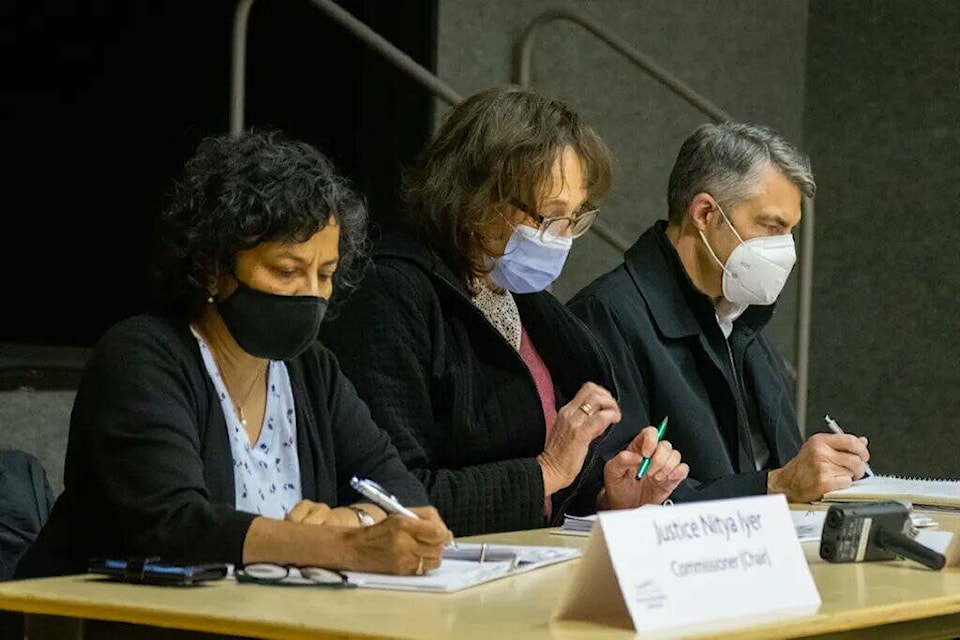The BC Electoral Boundaries Commission met with members of the public in Terrace on April 27 as part of its preliminary consultation process in the north.
The three-person commission consisting of B.C. Supreme Court Justice Nitya Iyer as chair, the province’s Chief Electoral Officer Anton Boegman and Linda Tynan, an independent government management consultant, heard from several members of the community at the Best Western hotel on Greig Ave.
Members from local governments, business community and First Nations gave their opinions and concerns to the commission in the event the number of electoral ridings were to be reduced or merged.
Most said changes, if made, would lead to inadequate representation in the legislative assembly for northern communities spread across expansive geographical distances and further compounded by transport and connectivity issues. If ridings are made larger it would also pose a problem for people to access their MLAs .
The commission has been tasked by the BC government to make recommendations on new provincial electoral boundaries before the next election.
Under legislative requirements set in the Electoral Boundaries Commission Act, the commission must seek to recommend electoral districts with populations within plus or minus 25 per cent of the average electoral district population, which is about 57,000 people.
The commission is empowered to recommend the creation of up to six additional seats in the BC Legislature, meaning the total number of seats may be raised to a maximum of 93, up from 87. The commission may also choose to recommend the merging of existing electoral districts.
Northern BC, which has a population of just over 300,000, is currently represented by nine MLAs. Should the commission choose to adjust riding boundaries to represent the provincial average, the number of seats in the north could be reduced to less than six.
According to the commission’s website three northern ridings are well below the minus 25 per cent mark, with Stikine at minus 64 per cent, Skeena minus 48 per cent and the North Coast minus 62 per cent.
With one possibility of the Skeena and North Coast ridings merging, the elected representative would have to serve a population of over 52,000 spread across 175,000 square kilometres.
With the NDP government having amended the Electoral Act in May 2021 to remove boundary protections of rural ridings, concerns were also raised about the process being a political move to undermine BC Liberal strongholds in these communities. The commission was called on to exercise its commitment to a non-partisan approach by not recommending either dissolution or merger of any of the northern ridings.
The commission also heard from the public about the unique economic and social challenges they face here, further indicating the need for representation in Victoria.
“Skeena is a microcosm of the challenges faced by the province as a whole, ” said Terrace resident Lael McKeown, speaking about the Skeena riding.
Terrace & District Chamber of Commerce urged the commission to refrain from recommending the merger of ridings since it affects economic development in communities that have diverse interests, such as the port in Prince Rupert, liquefied natural gas project in Kitimat and the mining projects spread across the Tahltan territory.
“Effective representation,” will be a challenge if ridings are merged, especially when “Decisions are being made for us by individuals [in the government] who have never stepped here,” said Tom Keller, President of the chamber.
As such there is “significant risk” that communities in northern and rural British Columbia will lose representation in the Legislative Assembly.
The District of Kitimat said the size of the geographic area of the riding should be formally considered in determining riding boundaries.
“The larger ridings bring with them land use issues, mineral, oil and gas and forestry issues that can require a significant focus on the part of the MLA representing the riding,” spokesperson Cameron Orr told the commission on behalf of the local government.
“These are issues that typically fall outside the area of concern of MLAs for geographically smaller urban ridings, yet consume a portion of the rural MLAs available time,” he added.
The commission was also asked if it is consulting with First Nations spread across the northwest stretch, keeping in line with the province’s adoption of the Declaration of Rights of Indigenous Peoples Act.
The commission began its review last November and will produce a preliminary report this October, following which there will be six months for comment before a final report is produced.
The commission will hold in-person meetings with 15 communities up until May 11, including Smithers, Quesnel, Williams Lake, Prince George, Vanderhoof, Dawson Creek, Fort Nelson and Dease Lake.
Virtual public meetings for north and interior communities will also be held on May 3 and May 13.
The full schedule can be accessed here.
READ MORE: B.C. Electoral Boundaries Commission seeks input from northerners
